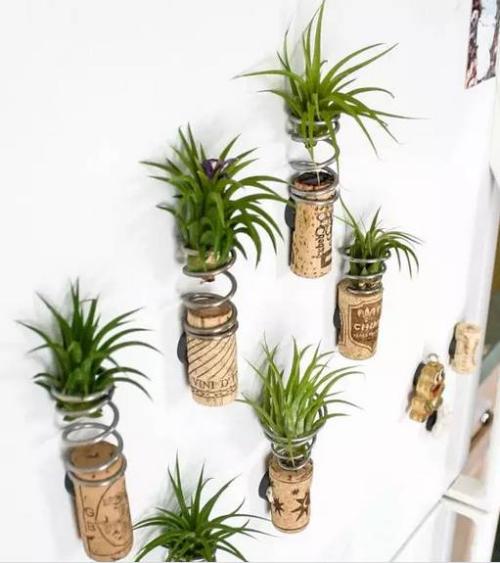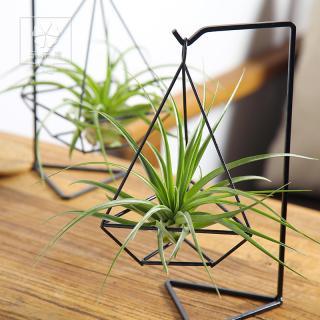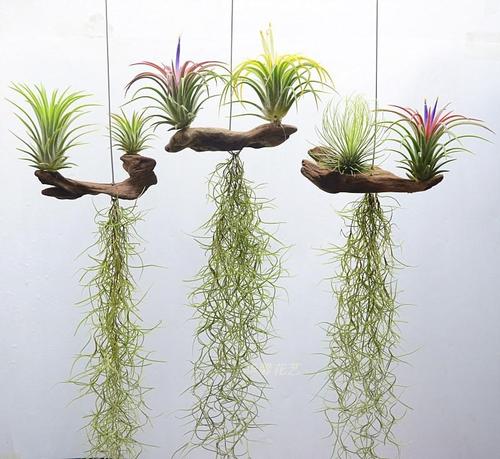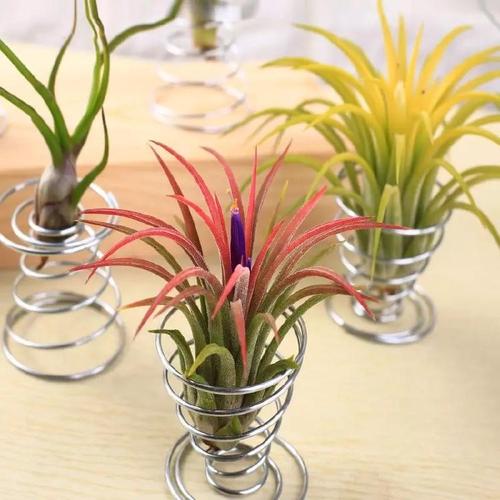Tillandsias Profile
Written by Lisa
Nov 09 2020

Tillandsia is also called Airplant. It is the only plant on earth that is completely born in the air. Tillandsia can grow luxuriantly without soil and can bloom bright flowers. They have many varieties and different shapes. They can admire leaves and flowers, and have the advantages of good decoration effect and strong adaptability. Let's take a look at the airplant together!
Tillandsias Picture


Tillandsia Morphological characteristics
Tillandsia is a perennial herb. There are many varieties, some of which can reach up to 2 meters in diameter and some are less than 10 cm in diameter. The plant is in the shape of a rosette, tube, linear or radial, and the leaves are lanceolate, linear, upright, curved or curled at the tip. In addition to green, the leaf color also has grayish white, blue-grey and other colors. The leaf color of some Tillandsia varieties will be beautiful red under the condition of full sun.
The leaf surface is densely covered with white scales, but there is no "water storage tank" in the center of the plant. Spike-like or compound spike-like inflorescences are drawn from the center of the leaf clusters, and the flower spikes have densely growing and colorful flower bracts or green to silver-white bracts. Small peanuts are green, purple, red, white, and yellow within the bracts. It has 3 petals, and the flowering period is mainly from August to April of the following year. When the capsule is mature, it splits automatically, and the seeds with feathery crests are scattered, which drifts in the wind and spreads everywhere.
Tillandsia Growth environment
Airplant does not need to be planted in the soil or in water. It is a special plant that can grow as long as it is sprayed with water. Tillandsia can absorb moisture and nitrogen compounds in the air by the fluff of the leaf, and can live without special care, but the growth is quite slow.
Tillandsia grows in tropical and subtropical rain forests or arid mountains at an altitude of 100-5000 meters. It is attached to tree trunks, stones, or crevices of cliffs, and a few grow on cacti. The biggest difference between it and terrestrial plants is that its roots do not have the function of absorbing water and nutrients, but only serve to fix plants and exchange a small amount of air. Nutrients and water are absorbed by the silver-gray fluffy scales on the leaf surface, and planting in water or soil basically cannot survive.

Most varieties of Airplant are native to tropical or subtropical regions in Central and South America, and grow on flat ground or high mountainous areas at an altitude of 1000-3000 meters. There is aridity and little rain, strong sunshine, and large temperature changes, but there is fog all year round. Moisturizing. The unique ecological environment makes Tillandsia have unique habits. In the original place, these plants are mostly attached to cacti, stone walls, dead wood, telephone poles, eaves, etc., so they do not need pots and soil when planting, and they can be hung. Get up or stick to dead wood, walls and other objects or put it in other shallow containers. For potted plants, coarse gravel, stones, etc. can be used as cultivation medium to fix plants
Tillandsia is resistant to drought and strong light, and its root system is very underdeveloped. Some varieties do not even have roots. Even if they have roots, they can only serve as a fixed plant, but cannot absorb water and nutrients. So how does Tillandsia absorb water? Close observation will reveal that there are many small white scales on the leaf surface. These scales are mostly shield-shaped depressions. The moisture or rain in the air will be intercepted by the stomata in the depressions and penetrate into the plant through the gaps of parenchyma cells. Generally, the pores in these scales are semi-closed during the day when the temperature is relatively high and the air is relatively dry to reduce water evaporation; when the temperature decreases and the air humidity increases, the pores are fully opened at night to absorb moisture in the air.
Most varieties of Tillandsia grow in a dry environment, and a small part prefer a humid environment. The leaves of varieties that grow in rainforest climates or other areas with more humid and tree-shaded areas have broad, green-green characteristics, and the flowers that bloom are larger, but the flowers are more monotonous. They live on another plant or tree trunk in an epiphytic manner, and over time, they will gradually grow roots, which can fix the plant itself and propagate the next generation from seeds or lateral buds. Varieties in dry areas have completely different appearances.
Tillandsia Distribution range
Tillandsias are mainly distributed in the Americas, from Virginia in the east of the United States through Mexico and Central America, extending to southern Argentina. Most of the varieties come from Latin America. This wide range of distribution shows its strong adaptability. Many species inhabit swamp areas, tropical rainforest areas, fog forest areas, and some live in arid and hot deserts, rocks, trees (even cacti), telephone poles, power lines in mid-air, rocks, etc. It stretches for thousands of miles in an epiphytic manner, and there are traces of them on mountains from sea level to two or three kilometers. Some of the few native species are restricted to be distributed in a single valley or mountain area. Because of their special growing conditions, most native species of Tillandsia grow in dry environments, a few are in Mexico, and others are distributed in South America, Brazil, Costa Rica, etc. Country’s mountains. There are also a few rare species distributed on some small islands in the Bermuda waters.
Cultivation method of Tillandsia

Cultivation containers of Tillandsia mainly include shells, stones, dead wood, tree fern boards, rattan baskets, etc., and can be fixed with iron wires and ropes. They can also be pasted on the container with universal glue or hot melt, or by hanging. To cultivate, tie it with copper wire or rope and hang it in the air.
Maintenance points of Tillandsia
1. Temperature control
The optimum temperature for the growth of Tillandsia is 15℃-25℃, and the general growth temperature is 5℃-40℃. If the temperature is higher than 25℃, ventilation and relative humidity should be strengthened so as not to cause growth stagnation due to excessive heat. Tillandsia can tolerate low temperature of about 5℃ in winter, and some varieties can tolerate low temperature of 0℃, but most varieties will be frostbite below 5℃, and plants will die below 0℃.
2. Light control
Tillandsias have different requirements for sunlight depending on the variety. The leaves are hard and gray, and require plenty of sunlight or strong scattered light. Indirect sunlight or general light is also acceptable. It is best to place them next to windows. Method, about 10 hours of light per day. The green leaves do not require so much light, and they can grow normally in semi-shady places or indoors. In addition, Tillandsias like to breathe fresh air. Although they can grow indoors, it is best to keep the air circulating.
3. Watering and humidity
The so-called no-watering of Tillandsia is when the air humidity reaches 90{bf} or more. During the growth period, spray water frequently to the plants to increase the air humidity and make them grow normally. It is recommended to use commercially available spray cans to spray evenly on the leaves. The method is to spray once a day in the dry season and 2-3 times a week in the wet season. Needle-leaf and flag-leaf type Tillandsias have little water storage. In any environment, water should be sprayed 4-5 times a week. The broad-leaved type has abundant water storage capacity and is suitable for growth in a relatively dry environment, so the number of water sprays can be maintained at two to two per week. When spraying water, just spray until the leaves are all wet, and don't let water accumulate in the center of the plant, so as to avoid "bad heart". It should be noted that it is better to dry the leaves 4 to 6 hours after they are wet, and note that some varieties of leaf cores are prone to water accumulation and can hang upside down to avoid stem rot.

4. Appropriate fertilization
In the wild, humus often accumulates in the epiphytic area of the Tillandsia, which can provide the nutrients needed for growth for its absorption. In the artificial planting environment, only relying on fertilization to supplement the nutrients for its absorption, can be sprayed every 20-30 days when the growth is vigorous, and it can be sprayed once every 20 to 30 days. Stop spraying in winter and flowering period. Some flower friends have summarized the practice of using beer to maintain Tillandsias, which can keep Tillandsias vigorous and bright. The specific method is to spray the Tillandsia leaf surface with clean water (distilled water is better) and beer every three to four weeks at a ratio of 50:1, or put the whole Tillandsia into beer diluted with clean water and soak for several minutes. Remove from the water and hang upside down to dry. This method can wash away the dust on the Tillandsia, which is beneficial to its breathing and absorption of nutrients, and the nutrients contained in beer are also very beneficial to the growth of Tillandsia.
5. Common diseases
Sunburn often occurs in an environment with sufficient light. The reason is that due to improper operation, the water spray on the leaf surface is not dried in time, and the water droplet acts as a convex lens to burn the leaf surface under the water droplet, but it will not spread. It is usually maintained. Pay attention to ventilation. Heart rot and root rot are often caused by high temperature and poor ventilation. In summer when the temperature is high, ventilation should be paid attention to to avoid excessive accumulation of water. At the same time, pay attention to avoid high calcium and sodium water quality. In terms of pests, common scale insects, snails, and slugs are common. For small domestic Tillandsia plants, it is recommended to improve ventilation conditions and use manual methods to remove pests.
Precautions of Tillandsia
1. Strictly speaking, it is not necessary to keep the temperature above 5°C in winter. If the daylight is good, it will be no problem at 0°C.
2. There is also a reminder that you should never plant it in a tank. Tillandsia requires a lot of air circulation, and it will break if the tank is stuffy. If the weather is too dry, just put the plant in water for about an hour. Then you can just shake off the water on the leaves. Also, don't bask in the sun when the leaves are wet. The leaves will be damaged. All Tillandsias are more resistant to drought. There is absolutely no problem if you don't supply water for several days.
3. Silver-leaf varieties are more resistant to drought than others. Please reduce watering frequency appropriately to avoid rot.
Most Tillandsias do not require as high air humidity as expected, and even in the production area, the air humidity will not be high when there is light during the day, but at night due to the temperature difference caused by the cooling, water vapor will condense on the plants Water is formed, which is then absorbed by the leaves.
As long as this feature is mastered, the water supply can be adjusted according to different cultivation environments. Generally speaking, the air phoenix only needs to supply water at night. The specific amount depends on the environment and the state of the plant. This needs to be determined by the grower. Flexible situation control.
Tillandsia is extremely resistant, and its resistance can reach its peak when it looks slightly dry. The seemingly tender plants have very low resistance and are prone to disease and rot when there is wind and grass. So when planting, let the plant dry slightly so that it can maintain a healthy state.
Latest Updated
- Benefits of Bugleweed - 7 Science-backed Health Benefits
- Bugleweed Dangers & Side Effects - Is It Poisonous?
- How to Plant Evergreen Trees - What You Should Know
- When to Plant Evergreens - Grow Guide for Evergreen Trees
- 12 Wonderful Evergreen Shrubs for Your Garden
- 12 Popular Evergreen Plants with Pictures for Beginners
- When And How To Prune A Lilac Bush Like a Pro
- How to Grow & Care for Lilac Vine (Hardenbergia Violacea)
- Japanese Lilac Tree (Syringa Reticulata) Care & Propagation Guide
- Shumard Oak Pros and Cons - What to Know
Popular Articles
- Winter maintenance of Antirrhinum Majus
- How to Grow Terminalia Mantaly Tree
- How to Grow and Care for Crossostephium Chinense
- How to grow Antirrhinum Majus in spring
- Peristeria Elata (Dove Orchid) Profile: Info & Care Guide
- Underwatered Snake Plant (Sansevieria Trifasciata) - Signs And How To Fix
- How to Care for Brazilian Jasmine Plant (Mandevilla Sanderi)
- How to Grow & Care for Graptopetalum Purple Delight in Summer
- Rosa Chinensis (China Rose): Plant Growing & Care Tips
- How to Care for Baby Sun Rose (Aptenia Cordifolia)